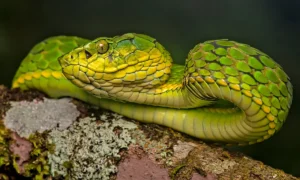The animal kingdom never fails to amaze with its diversity and peculiarities, and snakes, in particular, are known for their intriguing and often misunderstood characteristics. One question that might linger in the minds of curious minds is, “How many hearts does a snake have?“
Snakes, in fact, have only one heart. Unlike certain misconceptions or myths that suggest multiple hearts for these intriguing reptiles, the reality is that snakes possess a singular, well-developed cardiac organ. This single heart serves the vital function of pumping blood throughout the snake’s body, sustaining its various physiological processes.
While their anatomy might not align with some common misconceptions, the singular heart of a snake is a marvel of efficiency, aiding these remarkable creatures in navigating their diverse habitats.
Importance of Understanding Snake Anatomy

Understanding snake anatomy is crucial for various reasons, especially for those involved in herpetology, veterinary medicine, wildlife conservation, and even for snake enthusiasts.
Here are some key reasons highlighting the importance of understanding snake anatomy:
- Identification and Classification:
- Snake anatomy is essential for identifying and classifying different snake species. Each species has distinct physical features, scales, and anatomical characteristics that help in accurate identification.
- Health Assessment:
- Veterinarians and snake keepers need to understand snake anatomy to assess the health of individual snakes. Anatomical knowledge aids in recognizing signs of illness, injury, or abnormalities.
- Reproduction and Breeding:
- Understanding the reproductive anatomy of snakes is crucial for successful breeding programs. Knowledge of reproductive organs, behavior, and mating rituals is essential for the proper care and management of breeding pairs.
- Handling and Husbandry:
- Professionals and hobbyists alike must know snake anatomy to handle these animals safely. Understanding how snakes move, their musculature, and the location of sensitive organs helps prevent injuries to both the snake and the handler.
- Research and Conservation:
- Herpetologists and researchers study snake anatomy to learn more about their biology, ecology, and behavior. This knowledge is vital for conservation efforts, as it helps in understanding the role of snakes in ecosystems and formulating strategies for their protection.
- Medical Treatment:
- In cases where snakes require medical attention, veterinarians must be familiar with snake anatomy to diagnose and treat injuries or illnesses effectively. This knowledge is particularly important in the context of venomous snakebite treatment.
- Educational Purposes:
- Understanding snake anatomy enhances educational programs and outreach efforts. It allows educators to teach students and the public about the importance of snakes in ecosystems, dispelling myths and fostering appreciation for these creatures.
- Snakebite Management:
- Medical professionals dealing with snakebite cases need to understand snake anatomy to assess the severity of envenomation accurately. This knowledge is crucial for administering appropriate antivenom and providing effective treatment.
- Conservation Planning:
- Knowledge of snake anatomy contributes to conservation planning by providing insights into the specific needs and habitat requirements of different snake species. This information is essential for designing effective conservation strategies and protecting snake populations.


